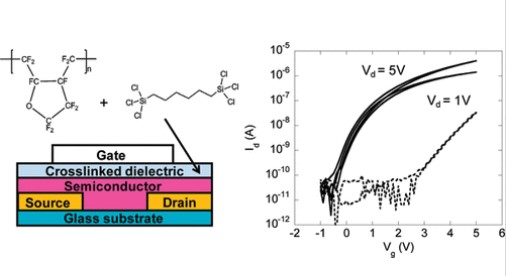Air Stable Cross-Linked Cytop Ultrathin Gate Dielectric for High Yield Low-Voltage Top-Gate Organic Field-Effect Transistors
- 저자
- Xiaoyang Cheng, Mario Caironi, Yong-Young Noh, Jianpu Wang, Christopher Newman, He Yan, Antonio Facchetti and Henning Sirringhaus*
- 저널명
- Chemistry of Materials, 22, 4, 1559-1566 (2010)
- 년도
- 2010
- Link
- https://doi.org/10.1021/cm902929b 492회 연결
[Abstract]
We demonstrate the use of a cross-linking chemistry for an amorphous fluoropolymer gate dielectric, poly(perfluorobutenylvinylether) commercially known as Cytop. Spin-coated films of Cytop exhibit good gate insulating properties as well as provide excellent OFET operational stability. However, these devices operate at large voltages because the dielectric layer thickness is typically ∼450−600 nm. When the thickness of a Cytop dielectric layer is decreased below 200 nm, the device yields are dramatically reduced due to pinhole formation. Our new cross-linked Cytop (C-Cytop) formulation deposited by spin-coating enables uniform thin films on top of various organic semiconductors that exhibits low gate leakage current densities (<10 nA mm−2) and high dielectric breakdown strengths (>2 MV cm−1). Our approach results in C-Cytop dielectric films as thin as 50 nm, thus allowing the fabrication of reliable p- and n-channel top-gate OFETs operating at very low-voltages (<5 V). The most remarkable properties of this new C-Cytop gate dielectric are the excellent device yields (∼100%) for thicknesses <100 nm and the dramatically reduced sensitivity to the underlying semiconductor film morphology. This new approach represents a significant advance compared to cross-linked PMMA films (C-PMMA) and other nonfluorinated polymer dielectrics on identical test structures. Furthermore, C-Cytop-based OFETs exhibit reduced bias stress and better air stability with respect to C-PMMA because of the inert perfluorinated chemical structure of this polymer. Finally, direct spectroscopic evidence of the cross-linking process was obtained by Fourier transform infrared (FTIR) spectroscopy, demonstrating complete reaction in air and at room temperature.
